When I wander the winding, cobblestone streets of Albarracín, it truly feels like I’ve stepped into a storybook. Terracotta houses climb the hillside, and somehow, every corner catches the golden Spanish sunlight just right.
If you want to capture the true magic of this fairytale Aragonese village in your photos, knowing where and when to shoot really does make a difference.
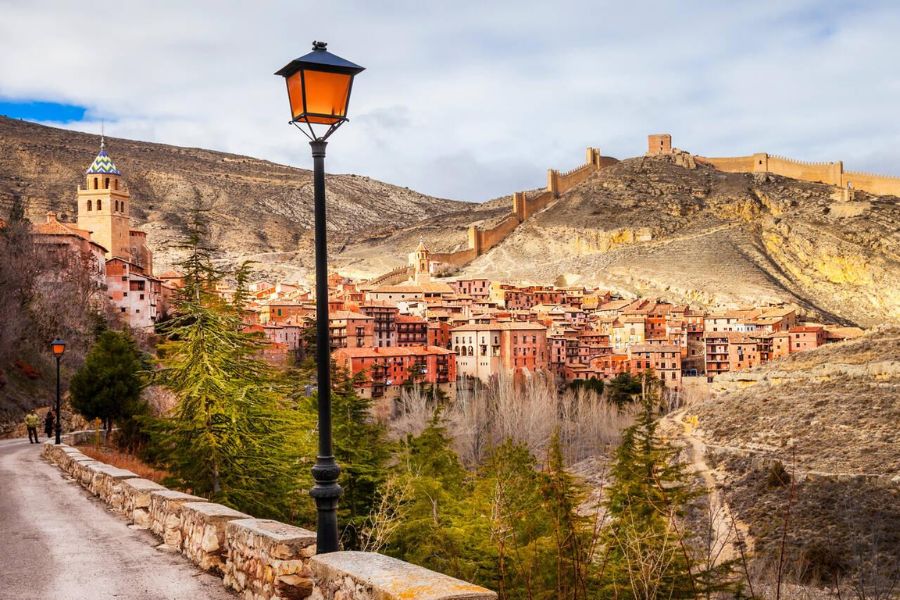
From hidden passageways to sweeping views of ancient walls, I keep finding spots that beg to be photographed. Even if it’s your first visit, these tips should help you bring home stunning images and memories.
Planning Your Photography Adventure in Albarracín
If you want a successful photo trip to Albarracín, a bit of planning goes a long way. The right time, decent gear, and knowing how to move around the old streets can completely change your photos.
Best Times of Day and Year for Shooting
Light transforms Albarracín. When I visited in spring, sunrise washed the pink stones in pale gold, and every alley glowed with magic.
Early mornings mean fewer people and gentle light—perfect for wide shots and empty plazas.
Late afternoons turn the clay-colored buildings nearly red. That’s when shadows stretch and add depth to the old walls.
I find the “golden hour” before sunset the best for capturing the famous walls winding up the hill.
Seasons matter, too. Spring and fall bring the best colors and mild weather.
In autumn, the trees along the river pop with reds and yellows. Summer is hotter and busier, but the long daylight is great for exploring.
I usually avoid winter unless I want snow scenes, since it can get cold and the streets might be slippery.
Essential Camera Gear and Accessories
I try to keep my kit as light as possible in Albarracín. The town’s charm lives in its details—a wide lens (16-35mm) lets me capture the tight streets, while a simple 50mm works well for portraits or unique doors and windows.
A tripod helps with early morning or night shots. I use a small, packable one because the streets are uneven.
Polarizing filters cut glare from the stone walls, and a lens cloth always comes in handy for dusty days.
Backing up photos each night is a must, so I carry extra memory cards and a portable charger.
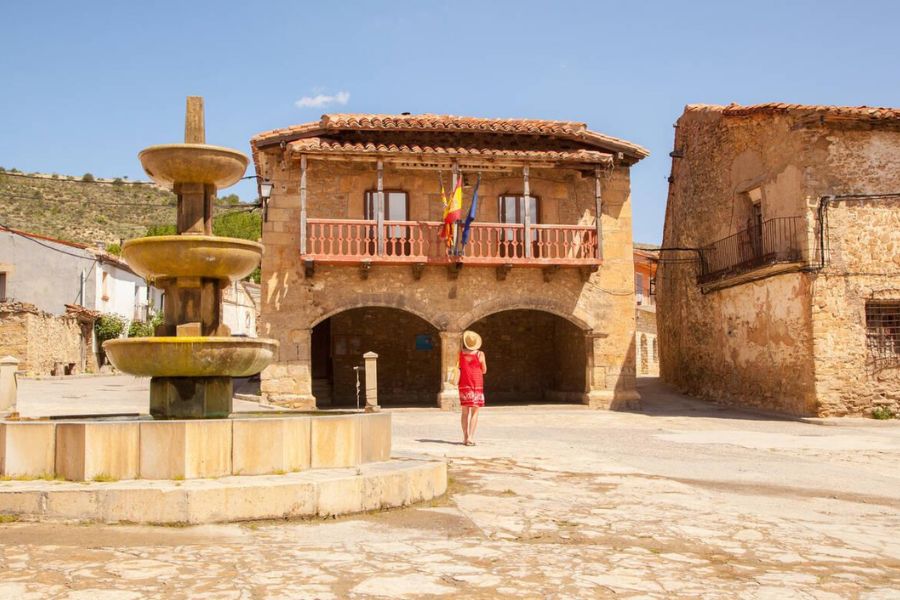
A lightweight daypack keeps the load off my shoulders but still holds snacks, a map, and water.
Navigating the Cobblestone Streets with Equipment
Albarracín’s steep, cobblestone lanes can be tricky with a camera bag. I wear sturdy walking shoes with good grip to avoid slips and pick a backpack with padded straps.
Sling bags slide too much on uneven ground, so I skip those.
Some spots only have stairs. For those, I pack just what I’ll need for a few hours, so I’m not hauling extra weight.
Before sunset, I choose a route and scout the best places for golden hour.
When the light changes fast, having my gear organized lets me move quickly and not miss a shot.
Sometimes I pause on a stone bench to check my photos and plan my next stop.
Albarracín isn’t huge, but its winding passages are best explored on foot—camera in hand, ready for magic around every turn.
Iconic Photo Spots Around the Village
Albarracín overflows with scenes that look straight out of a storybook. Every turn offers a new chance to snap a photo that feels unique and timeless.
Panoramic Views from the Town Walls
When I climb up to Albarracín’s ancient walls, I always find the best wide-angle shots. The old stone fortifications snake up the hill, opening up a sweeping view of the terracotta roofs below.
Early morning or late afternoon brings soft light, so I plan my visit around sunrise or sunset.
From the highest points, the rugged pink buildings seem to glow against the green hillside. I like using the winding path below as a leading line that draws the eyes into the village.

A tripod steadies my camera, especially for blue hour photos with slower shutter speeds.
I suggest experimenting with different focal lengths—sometimes the smallest details, like chimney pots or laundry lines, tell the best stories.
Capturing Plaza Mayor’s Timeless Charm
Plaza Mayor, the main square, pulses with daily life in Albarracín. I like to arrive early, before the cafes fill up, to photograph the quiet charm of the wooden balconies and arcades.
Sunlight bouncing off the old stone arches creates dramatic shadows in the mid-morning.
Focusing on details—the clock tower, faded crests, rustic benches—helps capture the square’s history.
When a local market or townsfolk appear, they add life and movement to my shots.
The square’s warm hues really stand out after rain, when the stones reflect the sky for moodier photos.
The Colorful Houses Along the Guadalaviar River
Down by the Guadalaviar River, I always find some of the most colorful photos in town. The pastel houses, with pink and orange facades, line the riverbank and mirror themselves in the water.
A walk along the riverside path gives me plenty of angles to frame the houses with trees, bridges, or wildflowers.
I like to shoot just before sunset, when the colors and reflections are at their richest.
On some mornings, mist adds a dreamy layer. I keep an eye out for reflections—they add extra depth to the scene.
If I’m lucky, I catch ducks or locals crossing the footbridge for more candid shots.
Photographing the Medieval Castle
Albarracín’s medieval castle towers above the village. From certain viewpoints, it looks isolated and dramatic, perched high on the hill.
I love walking up the winding path to the castle, stopping for shots where the ramparts peek between ancient trees.
Up close, I focus on the textured stonework and narrow windows—details that hint at centuries past.
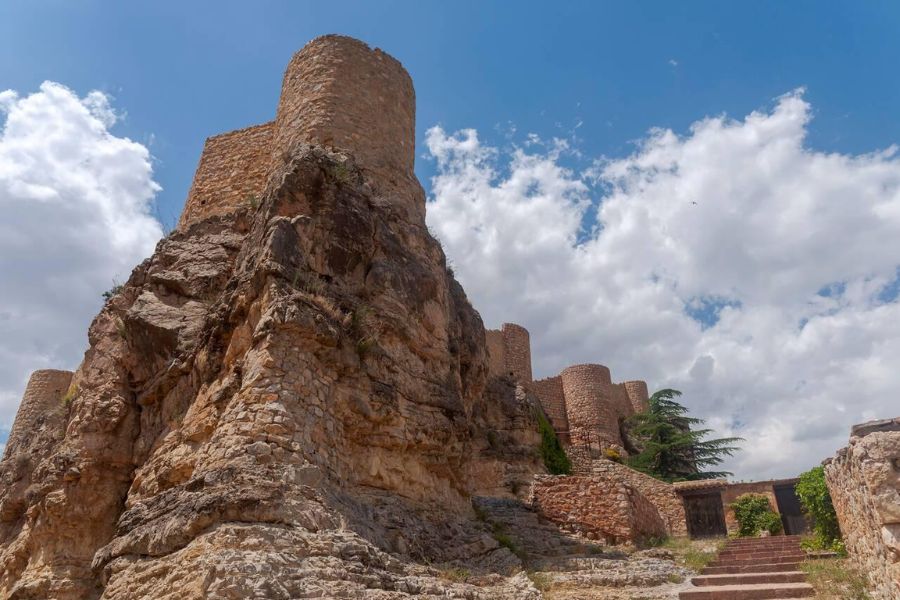
The castle looks most photogenic in late afternoon, when the golden hour sunlight brings out reds and browns in the stone.
I make sure to take wide shots with the whole town below, then zoom in on the battlements for a sense of scale and history.
Hidden Corners and Unique Angles
Albarracín is packed with hidden spots that reward a curious eye. The best photos often come from exploring narrow streets, looking up at bold colors, and noticing details that most people walk past.
Exploring Serpentine Alleyways
I usually start my photo walks in Albarracín by turning down side streets without a plan. The alleyways twist and rise, often ending at scenic viewpoints over the town’s tiled roofs or stone walls.
Shadows and sunlight shift every few minutes, creating ever-changing scenes.
The tightness of these lanes pulls buildings close, framing every shot naturally. I often crouch or shoot from eye level with the old cobblestones.
Picking alleys with hanging flowers or faded red walls adds pops of color.
When tourists crowd the main squares, these hidden paths stay quiet. That gives me time to slow down, adjust my camera, and shoot without waiting for a clear view.
Albarracín’s alleys never disappoint—they’re a treasure for anyone craving texture and depth.
Chasing Light in Secret Courtyards
Many of Albarracín’s courtyards hide behind arched doors or between old houses. I look for open gates or glimpses of green, then peek in to find little gardens in soft afternoon light.
These courtyards are perfect for practicing shots with changing light.
I wait for beams from above, casting shadows through vines or onto patterned tiles. Early morning and evening bring the best golden and blue tones.
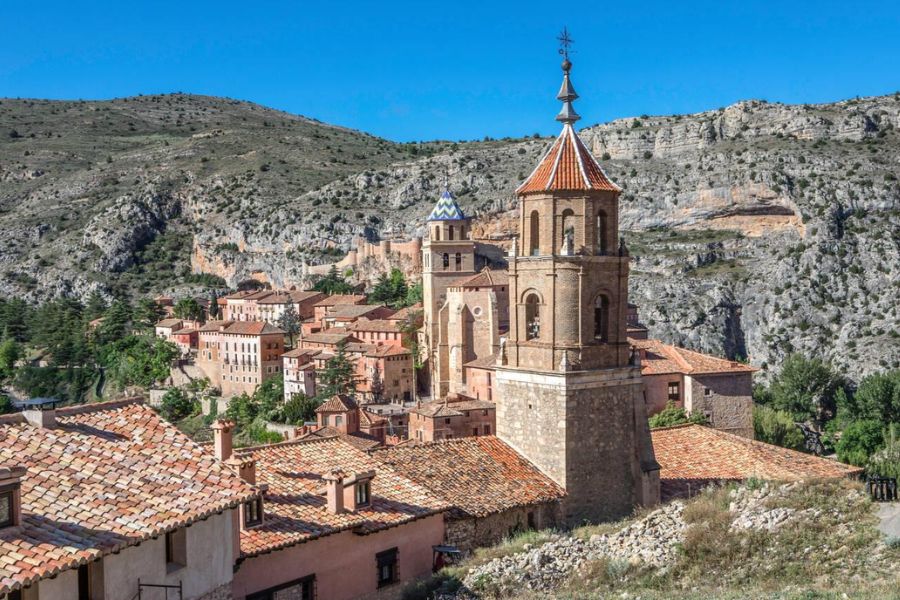
Sometimes I ask a local if I can take a quick photo inside a courtyard, and most people are welcoming.
Even without people, these spaces tell stories—weathered benches, chipped ceramics, clotheslines fluttering overhead.
It’s all about patience and watching how the sun moves.
Doors, Windows, and Local Details
I can’t get enough of Albarracín’s doors and windows. Each one is different, painted in faded pastels or bright blues, with iron knockers or carved wooden frames.
I get close for detail shots or step back to include rough walls and crooked balconies.
Early in the day, soft light keeps harsh shadows away. Later, the afternoon sun makes colors pop against the old stone.
For extra interest, I search for hanging flowerpots, old mailboxes, or reflections of clouds in a windowpane.
Sometimes a cat sits on the sill, or a local walks by—those little surprises can make a simple photo feel alive.
I always keep my lens ready for these moments.
Creative Photography Tips for Albarracín’s Magic
Albarracín’s winding streets, reddish walls, and ancient towers offer endless photo possibilities. I’ve learned that noticing light, hunting for unique textures, and seeking out daily life will get you the best shots.
Working with Changing Light and Shadows
Morning and late afternoon are the best times for soft, golden light in Albarracín. I love how the sun creates gentle shadows on sandstone walls and narrow alleys.
I pay attention to how light moves along the village streets. Shadows grow and shrink fast, so patience pays off.
A spot that looks flat midday will glow as the sun drops lower.
Cloudy days bring even lighting, which is perfect for capturing color and detail in the rooftops.

If it gets too bright, I just use my hand or a hat to block harsh sunlight from the lens.
Tip:
Keep a small notebook and jot down where you spot “good light.” Returning to those spots later made a big difference in my photos.
Composing with Leading Lines and Textures
Albarracín is full of winding staircases, stone paths, and wooden balconies. These details make great leading lines that guide the viewer’s eye through a photo.
I look for rows of terracotta tiles or ancient wall textures. Sometimes I kneel or get close to the ground so lines or cobbles pull you into the shot.
Doorways painted in bright colors can frame the scene or lead to a surprise around the corner.
Here’s what I keep an eye out for:
- Curved streets that draw attention into the distance
- Balcony railings adding a foreground layer
- Textured walls for depth and interest
Textures add richness, especially in close-ups. Old doorknockers, peeling paint, and rough stones invite you to imagine what it feels like to walk those streets.
Storytelling Through Local Life and Traditions
Photos of Albarracín come alive when they show local life. I look for moments like neighbors chatting in the square or kids chasing each other under the castle walls.
It’s important to stay respectful and friendly. A quick “¿Puedo tomar una foto?” (May I take a photo?) helps break the ice with locals.
Festivals and market days fill the town with color and activity. Traditional costumes, handmade crafts, and food stalls all help tell Albarracín’s story.
I try to capture the rhythm of daily life—fresh bread delivered in the morning, or laundry swinging from a line in the breeze.
These little slices of everyday magic reveal what makes the village so special.
Making the Most of Your Stay: Essential Travel Insights
Staying in Albarracín is an experience all its own. Finding the right place to sleep, eat, and photograph can make every moment count in this picturesque village.
Accommodation Options for Photographers
Albarracín really surprised me with its cozy mix of hotels, guesthouses, and rural lodges. I loved how many of them had balconies overlooking the medieval rooftops and those pink cliffs.
If you stay near the historic center, you’ll find it so much easier to catch sunrise shots and stroll back after chasing the golden hour in the evening.
Some of the smaller hotels even set up special storage for camera gear. That definitely helped me relax, knowing my equipment was stashed away safely.
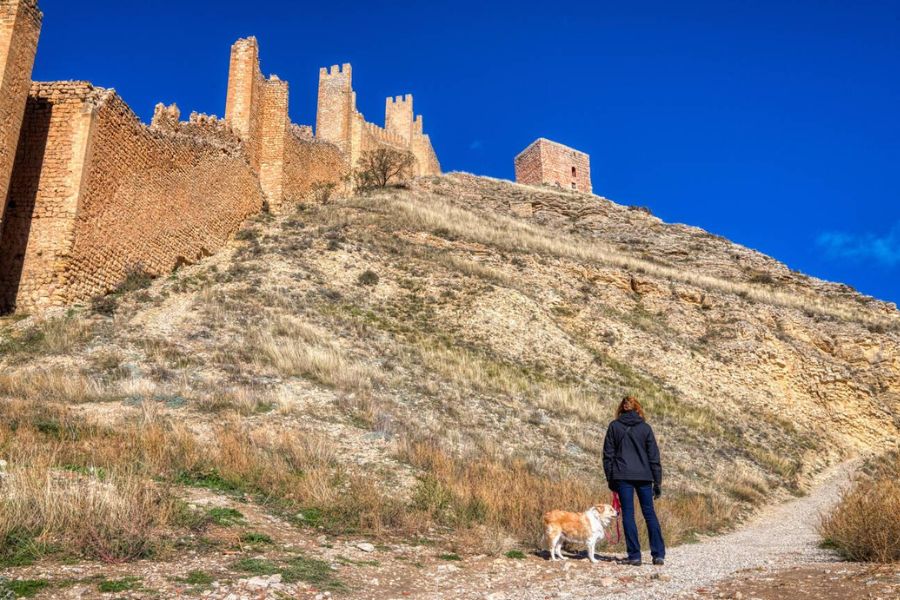
If you can, grab a room with a window facing the town walls. Watching dawn spill over the stone? Honestly, it was unforgettable.
Here’s a quick table I put together that helped me compare my options:
| Type | Example | Perks |
|---|---|---|
| Small Hotel | Hotel Albarracín | Town views, close to main sites |
| Rural Lodge | Casa de Santiago | Charming, quiet, rustic vibe |
| Budget Hostel | Albergue Tiempo de Setas | Affordable, social options |
I always checked reviews to see if WiFi was decent and if they offered early breakfast. Both are super handy when you need to edit or upload photos before heading out again.
Where to Eat and Recharge
After roaming around with my camera all morning, I couldn’t wait to hit Albarracín’s cafés and restaurants. Most spots serve classic Aragonese dishes—tender lamb, migas, those hearty stews—just what you need to keep going on a long photo walk.
For a quick pick-me-up, I ducked into little bakeries for a pastel or a strong coffee. Sometimes, that’s all you need.
I stumbled on a tiny tapas bar next to Plaza Mayor—friendly folks, zero fuss if I wanted to sort memory cards while eating. That place became my go-to.
Trying local specialties during festival season added a fun twist to my meals. It’s a nice reminder you’re somewhere special.
Oh, one last thing: if you’re visiting on weekends, book a lunch table ahead of time. The best places fill up before you know it.
Responsible Photography Etiquette
Albarracín feels warm and inviting, but let’s not forget—people actually live here. I always asked before snapping photos of locals, especially during festivals or market days.
Honestly, just smiling and saying, “¿Puedo sacar una foto?” made a huge difference. Folks usually appreciated the courtesy, and sometimes, those little moments turned into real conversations.
I left my flash off in dim places like old shops or churches. The natural light just felt right, and I didn’t want to mess with the mood or risk damaging anything.
I also kept things quiet, especially early in the morning or late at night. Blending in helped me enjoy the peaceful streets without bothering anyone.
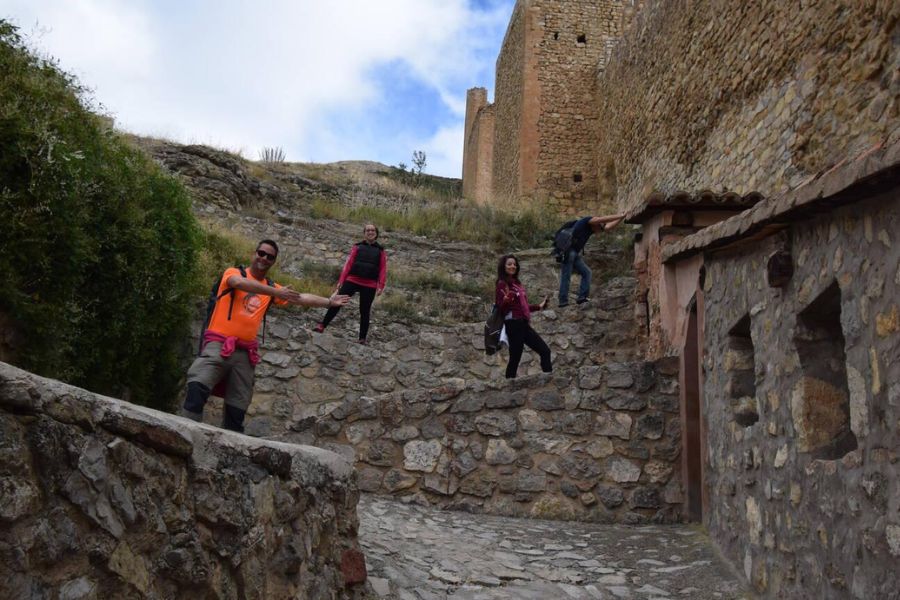
When I set up my tripod, I made sure not to block narrow paths or doorways. If a neighbor or a shopkeeper needed to get by, I stepped aside. It just kept everything easy and pleasant for everyone.

